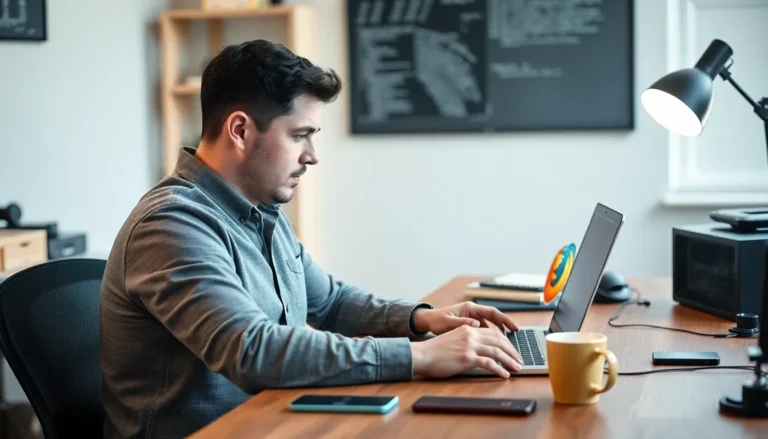In a world where smartphones are practically an extension of ourselves, the question arises: can an iPhone track an Android phone? It sounds like the plot twist of a tech thriller, but the reality is a bit less dramatic. Imagine your iPhone, that sleek gadget you can’t live without, trying to play detective on your friend’s Android. Spoiler alert: it’s not as simple as sending a text.
Table of Contents
ToggleOverview of Phone Tracking
Phone tracking involves determining the location of a device, often through GPS, Wi-Fi, or cellular network. Various apps and features exist to enable this tracking. iPhone users can utilize Find My iPhone, which allows locating lost Apple devices. Android users have a similar option with Find My Device.
Tracking cross-platform presents challenges. It is essential to recognize that iOS and Android operate on different systems, impacting their interoperability. Limited support exists for direct tracking between the two. Users typically cannot use iPhone tools to track an Android device directly.
The use of third-party apps offers a potential solution. Some applications function across both operating systems, enabling shared tracking features. However, privacy concerns arise with data sharing. Users must review permissions and capabilities before adopting any app for tracking.
Additionally, location sharing options within social media apps contribute to tracking capabilities. Many messaging platforms provide features for sharing real-time location with friends or family. This functionality can help people know where their contacts are, regardless of the device type.
While iPhones cannot directly track Android phones, various methods and tools offer possible workarounds. Understanding these options empowers users to choose the best approach for their needs.
Tracking Capabilities of iPhone

iPhones offer various methods for tracking devices, yet interoperability with Android remains limited. Users can take advantage of the following built-in features and third-party apps.
Built-in Features
iPhones support location tracking through the Find My iPhone feature. This tool allows users to locate their device on a map, send alerts, or remotely erase data. While this functionality is thorough for iPhones, it does not extend to Android devices, preventing direct tracking. Many iPhone users rely on this feature for their own devices, ensuring security and peace of mind. Location services across all apps depend on GPS and Wi-Fi connectivity. Though effective, these built-in options emphasize that tracking an Android phone from an iPhone isn’t feasible.
Third-Party Apps
Cross-platform tracking often necessitates third-party apps. Various applications, such as Life360 or Glympse, facilitate location sharing among users, irrespective of their device’s operating system. These applications require permission to access location data, ensuring some level of privacy. Users can exchange live locations or check in with friends and family using these tools. Although helpful, such apps may come with privacy concerns, as they handle significant amounts of personal data. While they identify workarounds for tracking, users must weigh convenience against privacy risks.
Tracking Capabilities of Android
Android devices come with various tracking capabilities. Users can leverage built-in features to locate their phones. The most notable tool is Find My Device, which employs GPS and network data to pinpoint a device’s location. This service requires user configuration, ensuring privacy settings align with personal preferences.
Built-in Features
Key built-in features enhance location tracking on Android smartphones. Google Maps allows real-time location sharing with trusted contacts, making it easy to connect with friends and family. Location History, available in settings, logs movement patterns for users. Accessibility to these features depends on user consent, focusing on privacy while providing valuable assistance.
Third-Party Apps
Third-party apps extend tracking capabilities beyond built-in features. Life360 offers a comprehensive family locator solution, enabling real-time location sharing among members. Glympse presents another option, allowing users to share their location temporarily with others. These applications require permissions to access location data, promoting user control over their information. Users often prefer these solutions for cross-platform compatibility, enhancing tracking across different devices.
Can an iPhone Track an Android Phone?
Tracking an Android phone using an iPhone presents notable complexities. Various limitations and challenges complicate the process.
Limitations and Challenges
Directly tracking an Android device via an iPhone isn’t feasible due to operating system differences. iPhones rely on features exclusive to Apple’s ecosystem, making interoperability impossible. Third-party apps provide some potential, yet they require user consent for location sharing. Privacy issues often arise, deterring users from relying on these solutions. Additionally, inconsistent app functionalities across platforms create further challenges. Variations in GPS accuracy and connection strength may also affect tracking effectiveness, complicating user experience. Limited direct access to data hinders comprehensive tracking, thereby reducing the reliability of various available methods.
Legal and Ethical Considerations
Legal implications accompany any attempt to track a device. Users need to consider consent requirements mandated by privacy laws like the General Data Protection Regulation (GDPR). Ethical concerns regarding personal privacy frequently arise when tracking individuals without their knowledge. Users risking non-compliance with legal standards may face significant penalties. Trust issues can also emerge in relationships if tracking is perceived as invasive. Understanding the legal landscape becomes crucial for anyone contemplating cross-platform tracking. Therefore, balancing user intentions with ethical responsibilities remains essential for responsible tracking practices.
Tracking an Android phone using an iPhone isn’t a straightforward task due to the inherent differences in operating systems. While both platforms offer their own tracking tools like Find My iPhone and Find My Device users need to rely on third-party apps for any cross-platform functionality.
These apps provide potential solutions but come with privacy considerations that users must carefully weigh. Navigating the complexities of device tracking requires an understanding of both technological capabilities and legal obligations. Ultimately users should prioritize consent and privacy while exploring the best methods for their tracking needs.



